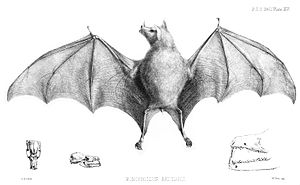Monophyllus
| Monophyllus | ||||||||||||
|---|---|---|---|---|---|---|---|---|---|---|---|---|

|
||||||||||||
| Systematics | ||||||||||||
|
||||||||||||
| Scientific name | ||||||||||||
| Monophyllus | ||||||||||||
| Leach , 1821 |
Monophyllus is a genus of bats from the family of leaf noses (Phyllostomidae) whichis nativeto the Caribbean islands . Only two species are known: Monophyllus plethodon ( Leach , 1821) and Monophyllus redmani ( Miller , 1900).
description
The main difference between the genus Monophyllus and other flower bats is the details of the teeth. The two species of the genus are rather small bats , but have, as is typical for the subfamily of the flower bats, an elongated snout and a long, retractable tongue. The tail flight membrane is narrow and the tail protrudes about halfway above the tail flight membrane. The Greater Antilles is monophyllus the only genus of flowers bats. In Jamaica and the Lesser Antilles, however , their range overlaps with species of the genus Glossophaga . With a total length of 67–84 mm, a forearm length of 38.8–45.7 and a weight of 12.5–17.2 g, M. plethodon is somewhat larger than M. redmani with a total length of 60–80 mm and a forearm length of 34.8-42.8 mm. The two types can only be distinguished by their teeth and their distribution.
Way of life
Both species of the genus Monophyllus are nocturnal, like most bats. Like the other representatives of the flower bats, they feed on nectar, pollen and fruits, although it is also likely that insects are ingested from time to time. During the day, both species hang in caves, whereby M. redmani seems to prefer large, deep caves with high humidity. Other species of bats such as Natalus micropus , Mormoops blainvillii , Pteronotus parnellii , Pteronotus macleayii and Phyllonycteris poeyi are occasionally found in the same caves . By M. redmani to pregnant animals took place from December to February and May while pregnant females of M. Plethodon on Dominika were observed in March and April. A female caught in Guadeloupe in July was lactating. Both species only give birth to a single young per litter.
distribution and habitat
M. redmani is native to the Greater Antilles , while M. plethodon occurs in Puerto Rico and the Lesser Antilles , with no evidence for Grenada and St. Kitts and Nevis . The IUCN has assessed both species as harmless thanks to their likely large populations and their occurrence in protected areas.
literature
- RM Nowak: Walker's Bats of the World , Johns Hopkins Univ. Pr., ISBN 0-8018-4986-1 , pp. 141-142.
- JA Homan, JK Jones Jr. (1975): Monophyllus plethodon. In: Mammalian Species . No. 58, pp. 1-2.
- JA Homan, JK Jones Jr. (1975): Monophyllus redmani. In: Mammalian Species . No. 57, pp. 1-3.
swell
- ↑ Monophyllus redmani in the IUCN Red List of Threatened Species .
- ↑ Monophyllus plethodon in the IUCN Red List of Threatened Species .